Four of us had planned on this trip. We had settled on the Ahmadpur-Katwa line. This
trip had initially been planned for the coming week, but having to accomodate everyone, we had to predate it to
this date. Saurab Basu had been talking about doing this narrow gauge route. Arnab Sengupta and Saibal Bishnu,
due to reasons beyond control, had to cancel their participation on the eve of the trip, leaving only Saurab and
I to fend for ourselves. We had initially planned to get reservations by either the Ganadevta or the Kanchanjunga
Expresses, but there were huge waitlists, primarily because Pous Mela was on at Shantiniketan (Bolpur).
As requested Saurab woke me up at 4.30 am by a call. Got ready and got my gear and jumped into a cab. We had planned
the 0620 EMU (M-209) departure from Howrah (a Barddhaman local via the chord line). Found myself in a traffic jam
on Howrah Bridge at 5.30 am!!! Finally crawled my way into Howrah and found Saurab at the station. He had already
got the tickets and we headed to the platform. Saurab had found out there was a local (C-245) leaving earlier,
at 0610, which would take the chord line, reaching Barddhaman earlier. We jumped aboard and found ourselves window
seats. I glimpsed outside while passing the loco shed and found two WAP-7s berthed there; I guess the Poorva would
be a contender for these beasts that morning. We stopped a couple of times outside the station and lost some time
due to rather unimpressive running, but yet made it to Barddhaman two minutes before schedule (at 0818) after the
95 km ride.
We had planned on taking the 0910 departure Barddhaman-Rampurhat DMU to get us to Ahmadpur, 71 kms from Barddhaman.
While waiting for it, we roamed around, looking for something to eat, and I managed to get myself an omlette with
bread. Moving on, we went towards the NG platforms (there is a service from here to Katwa - see here). There were
no trains about and some workmen were loading rails on a flatcar like contraption without a base.
The overbridge was crammed with people; waiting to find out on which platform the Rampurhat DMU would come into.
The train was late, and arrived about 30 minutes behind schedule, and left soon afterwards. Even though it was
a DMU rake, it did not have a diesel loco in the middle. It was sorted like a regular train, with the loco right
up at the front. The loco that had hauled it in was disconnected, and a fresh loco (WDM2 # 17916 of Barddhaman
shed) was attached to the front. There was a huge crowd waiting to board. We managed to squeeze our way in, and
parked ourselves close to the door. The train started off, over 30 minutes late as it made its way across to Khana
Jn, from where it would take the flyover and cross the main lines to head north towards Bolpur and beyond. Of course
it stopped at every station on the way and there were quite a few, the most important being Bolpur, where most
of the crowd got down there. Heaving a sigh of relief at being able to move our feet, we waited the as the train
passed the two in between stations, arriving at Ahmadpur about 45 minutes late, at 11.37. We were worried that
the NG train would have left on schedule, so at Ahmadpur, we didn't even look around at the station, we just made
our way to the eastern side, where at a distance the platform for the NG train is situated. After buying the tickets
(Rs 13 for the 52 km ride), we surveyed the train.
It was a Railbus. It comprised of four cars, the front having the drivers' enclosure. The livery was a pleasant
blue, and the coaches had CR markings. We found out they had recently been transferred here, which explained their
being in a good condition. They had large windows, dramatically improving their appearance. The interiors had a
clean look with bent plywood seats. We walked up to the driver and asked if we could take a look inside and he
agreed.
The can was spacious. There was a central box like structure in the middle, which housed the diesel engine (the
same that's used in buses). The windscreen was large and the cab very airy. The assistant driver's seat was on
the left. The driver sat on the right. He had a small horizontal panel with the necessary gauges, and two foot-pedals,
the clutch and the accelerator, and on left was the regular floor mounted gearshift. On the driver's right was
a wheel, which was the vacuum brake lever. Portruding from the dashboard panel was a lever for the horn.
This 2'6" line has a maximum permissible speed of 15 km/h. the driver told us that was almost impossible to
maintain and they often traveled faster, and they would leave the station late so as to reach the midway station
of Kirnahar ahead of time, take a long break there and then leave late so they would reach Katwa on time. The line
had a combination of metal and wooden sleepers, with no ballasting, though the driver said some track renewal was
planned for which included ballasting work. Interlocking was by means of paper ticket, and most of the stations
didn't have signals. Some that did have them were at times not functioning. The signals we saw had their lamps
and the colour lens missing. I asked the driver about that and they said they send a report about malfunctioning
and broken signals on a daily basis to the divisional headquarters, but nothing comes of it. Stations that had
signaling had the two levels situated on the platform. Only the last section has token, since it involves a crossing
with the broad gauge line.
We left Ahmadpur and continued our journey. The countryside was very pleasant, with a lot of greenery. The cool
weather made it all the more enjoyable. Mustard fields dotted the area, with mustard flowers in bloom. The area
around the track seemed pretty well developed, compared to the Barddhaman-Katwa line. The ride was reasonably rattly,
but that is to be expected of a secondary narrow gauge line. At all stations (13 along the way), the guard would
instruct the driver to start the train.
We stopped at Kirnahar for a considerable amount of time and had some good tea at the stall.
Two stations later, at Jnandas Kandra, the stationmaster informed over the wireless that the home signal wasn't
working and gave us authority to proceed. We incurred a crossing. The train in the opposite direction was a railbus
too, but this one was made of mixed stock. It had a reasonably new CR driving unit, but a mix of different liveried
trailers behind it. One was of an old design, with small windows. We halted and waited for the other train to enter,
which was put on the loop line (which had the platform - this is common to all stations with loop lines). We left
a little after the train arrived and then made our way towards Katwa.
At the last station before Katwa, Ambalgram, we were given a token, and I soon realized why. A little after the
station, the broad gauge line from Azimganj joined us, ran parallel for a bit and then we came to the bridge over
the Adjai river. Here, due to a lack of space, the narrow gauge line piggybacks over the broad gauge one, with
4 individual tracks, in effect becoming gauntleted track. This necessitates signaling and interlocking, hence the
provision of the token. Immediately after the bridge the lines separated, and then veered off to the left, while
we carried on, and the line coming in from Barddhaman met us, and then had a short double track section till Katwa
station. Katwa has only one platform for narrow gauge. The ground serves as the second platform if required.
Thanking the drivers and detraining, we made our way towards the workshop and locoshed. I had distinctly remembered
seeing steam locos, in a well-painted condition there. We soon found them, and were about to take photos when a
gentleman asked us if we had permission, I replied in the negative and then he mercifully waved us on. I asked
him how come the condemned steam locos were maintained in such good visual condition and he replied that they usually
carried out the paint job as decoration during the Jagaddhatri puja. We looked for builders' plates but were unable
to find any. A lone rusting boiler also greeted us at the other side.
Soon it was time to take our 1555 EMU (KS-2) departure back towards Calcutta. We had chosen a Katwa Sealdah local,
which is closer and more convenient than Howrah. We got our tickets and boarded. The train left on time but we
progressively got delayed due to numerous crossing en route on the single line stretch up till Bandel Jn. We were
almost 40 minutes late just before Bandel but reached Bandel just 10 minutes late, which shows how much of a allowance
this train has. From Bandel it took the Jubilee Bridge and crossed over towards Naihati, incurring many delays.
After Naihati, it ran as a fast local, stopping at only about five stations on the way. We were running pretty
late, but the train maintained good speed, and it is scheduled to reach Sealdah at 2015, taking 4 hours 20 minutes
for the 152 km run) I got off at Dumdum Jn with Saurab and after chatting with him a few minutes, boarded the following
local which took me to Sealdah.
I took a cab home, ending a fruitful daylong trip, which, due to the wonderful weather, did not prove to be the
least bit tiring.
A fact about this (and many other) trips is the total cost of the trip was lesser than the cab-fare to get to the
station and back!!! |
|
|
|
|
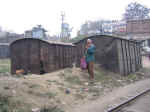
Old gods wagons used as sheds / storage at Barddhaman station
|
|
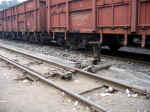
Narrow gauge turnout, Barddhaman station.
|
|
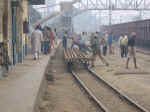
Loading rails onto a flatcar, Barddhaman station.
|
|
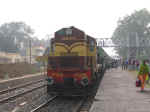
WDM-2 #17916, BWN shed, which hauled the Barddhaman - Rampurhat DMU, at Ahmadpur
station.
|
|
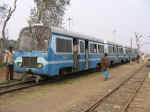
The narrow gauge railbus at Ahmadpur station.
|
|
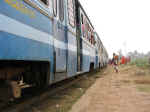
Another view of the NG railbus.
|
|
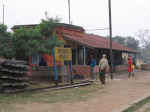
Kirnahar station, the most important station along the way.
|
|
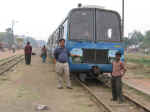
Me posing with the Railbus.
|
|
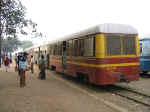
The mixed rake Railbus that crossed us at Jnandas Kandra.
|
|
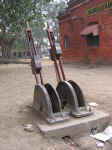
Platform level signal levers at Jnandas Kandra.
|
|
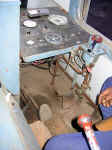
The driving console. Th eleft pedal is the clutch and the right teh brake. You can see the grearshift above teh
driver's leg.
|
|
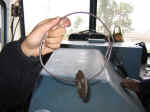
The token received at Ambalgram.
|
|
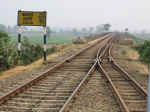
The BG and NG lines merging to cross the Adjai river.
|
|
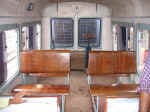
Interior of the railbus.
|
|
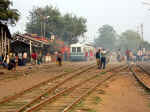
At Katwa station.
|
|
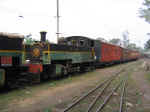
Old steam loco at Katwa workshop.
|
|
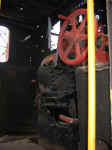
Inside the steam loco. Note bold use of colour.
|
|
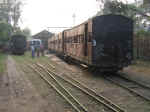
Rake parked at Katwa workshop / shed.
|
|
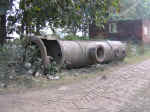
Old boiler at Katwa.
|
|
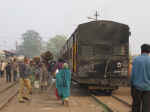
A dusty station provides atmosphere to this regular NG rake at Katwa.
|
|
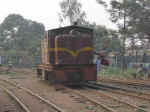
ZDM-5 #508 readies to attach itself to the rake of the Katwa-Barddhaman Passenger.
|
|
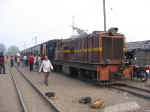
#508, LHF position readies to pull out with his charge.
|
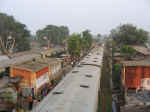
Overbridge view of Katwa station. |
|

